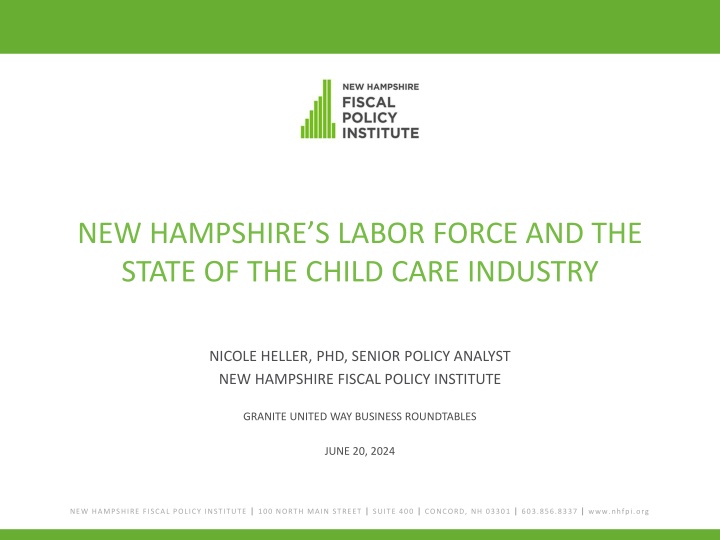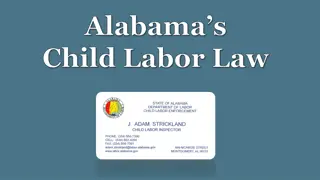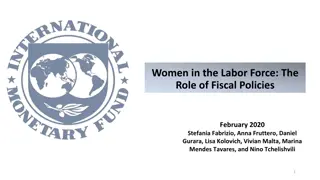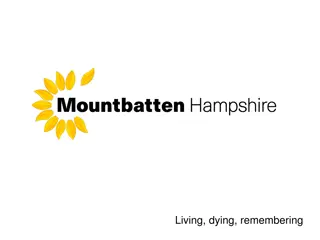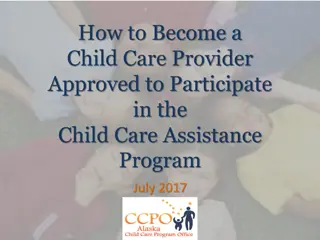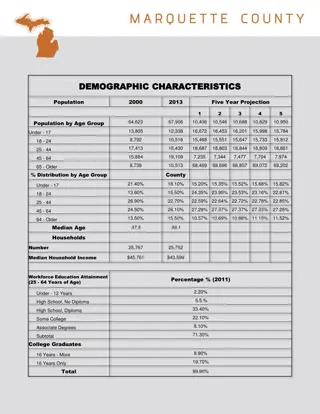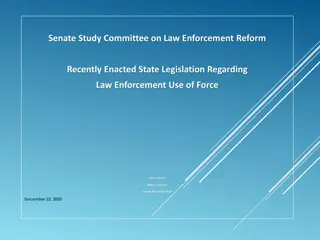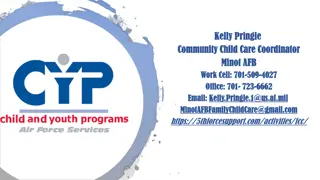New Hampshire's Labor Force and Child Care Industry Analysis
This analysis by Nicole Heller, PhD, Senior Policy Analyst at New Hampshire Fiscal Policy Institute, presents data on New Hampshire's labor force demographics and the challenges faced by the state's child care industry. It highlights the high cost of child care, lack of available slots, low wages for child care workers, and the impact on families and the economy. The report includes statistics on child care prices, workforce participation, and federal benchmarks for affordable child care.
Download Presentation

Please find below an Image/Link to download the presentation.
The content on the website is provided AS IS for your information and personal use only. It may not be sold, licensed, or shared on other websites without obtaining consent from the author.If you encounter any issues during the download, it is possible that the publisher has removed the file from their server.
You are allowed to download the files provided on this website for personal or commercial use, subject to the condition that they are used lawfully. All files are the property of their respective owners.
The content on the website is provided AS IS for your information and personal use only. It may not be sold, licensed, or shared on other websites without obtaining consent from the author.
E N D
Presentation Transcript
NEW HAMPSHIRES LABOR FORCE AND THE STATE OF THE CHILD CARE INDUSTRY NICOLE HELLER, PHD, SENIOR POLICY ANALYST NEW HAMPSHIRE FISCAL POLICY INSTITUTE GRANITE UNITED WAY BUSINESS ROUNDTABLES JUNE 20, 2024 NEW HAMPSHIRE FISCAL POLICY INSTITUTE | 100 NORTH MAIN STREET | SUITE 400 | CONCORD, NH 03301 | 603.856.8337 | www.nhfpi.org
QUIZ QUESTION What percentage of New Hampshire s labor force is age 16 to 44 years old? 2
QUIZ QUESTION What was the average price of child care for two children under five years old in center-based care during 2023? 6
CURRENT STATE OF NEW HAMPSHIRES CHILD CARE SECTOR Child care is unaffordable to most NH families In 2023, tuition for center-based care for an infant was over $17,000. Families paid about roughly $32,000 for two children under 5. Not enough child care slots available in NH to meet demand During 2018-2022, there was a shortage of about 8,400 child care slots. Between March 2023 and March 2024, an average of nearly 15,500 Granite Staters each month were not in the labor force because they were caring for children who were not in school or child care NH child care workers do not make livable wages, and many do not have benefits A typical NH child care worker earned approximately $32,500 in 2023. The federal poverty guideline for a family of 4 in 2023 was $30,000. In 2021, the U.S. Department of the Treasury reported profit margins for child care providers were usually < 1 percent Sources: Child Care Aware of America, NHFPI analysis of U.S. Census Bureau American Community Survey data, U.S. Bureau of Labor Statistics, U.S. Department of the Treasury 7
CHILD CARE PRICES INCREASED 12.5 PERCENT FROM 2022 TO 2023 8
FEDERAL BENCHMARK: AFFORDABLE CHILD CARE SHOULD BE NO MORE THAN 7 PERCENT OF HOUSEHOLD INCOME PERCENTAGE OF MEDIAN HOUSEHOLD INCOME NEEDED FOR TWO CHILDREN IN CENTER-BASED CARE Percent of Median Income for Households with Children during 2018-2022 Equivalent to the Unsubsidized Price of Tuition for an Infant and Four-Year-Old Child to Attend Center-Based Child Care Sources: Child Care Aware, U.S. Census Bureau s American Community Survey, U.S. Department of the Treasury 9
NEW HAMPSHIRE CHILD CARE SCHOLARSHIP ELIGIBLITY EXPANSION 10
QUIZ QUESTION What was the median wage for a child care worker in 2023? 11
NEW HAMPSHIRE EARLY CHILDHOOD EDUCATORS WAGES ARE NOT COMPETITIVE 12
PROJECTED HIGH TURNOVER AMONG CHILD CARE WORKERS 13
TRUE COST OF HIGH-QUALITY CHILD CARE Revenue from tuition and NH Child Care Scholarships may not generate enough funds to cover necessary program costs Costs may include: o Payroll and benefits o Professional development for staff o Food and diapers o Toys, furniture, and playground equipment o Curricula and assessments o Reducing child to teacher ratios, as needed o Cleaning supplies o Rent or Mortgage o Insurance o Utilities o Additional office and business expenses Difficult to streamline or consolidate child care costs due to unique business model 14
END OF ONE-TIME FEDERAL INVESTMENTS MAY REDUCE INDUSTRY STABILITY 15
QUIZ QUESTION Based on a Moody s Analytic Report from 2021, which policies have the best returns on investment? 16
KEY POINTS System is not working well for anyone: Majority of New Hampshire s labor force is of child-bearing age and over half of NH jobs are held by women, who are more likely to leave the labor force to provide care Affordable and accessible child care is needed for a robust labor force Child care is unaffordable to the majority of families Low wages and poor workforce retention Program revenues do not cover true cost of care Small, if any, profits for providers End of one-time funding for the sector Investments in children have favorable returns 18
ADDITIONAL RESOURCES Issue Brief: The State of Child Care in New Hampshire: End of One-Time Federal Investments May Reduce Industry Stability February 2, 2024 https://nhfpi.org/resource/the-state-of-child-care- in-new-hampshire-end-of-one-time-federal-investments-may-reduce-industry-stability/ Blog: Annual Price of 2023 Child Care for Two Granite State Children Under Five Averaged Nearly $32,000 May 15, 2024 https://nhfpi.org/blog/annual-price-of-2023-child-care-for-two-granite-state-children-under-five- averaged-nearly-32000/ Fact Sheet: Child Care in New Hampshire: High Price, Low Supply October 13, 2023 https://nhfpi.org/resource/child-care-in-new-hampshire-high-price-low-supply/ Resource Pages: Economy, Education https://nhfpi.org/topic/economy/ https://nhfpi.org/topic/education/ 19
ADDRESS: 100 North Main Street, Suite 400, Concord, NH 03301 PHONE: 603.856.8337 WEBSITE: www.nhfpi.org EMAIL: info@nhfpi.org TWITTER: @NHFPI FACEBOOK: NewHampshireFiscalPolicyInstitute 20
